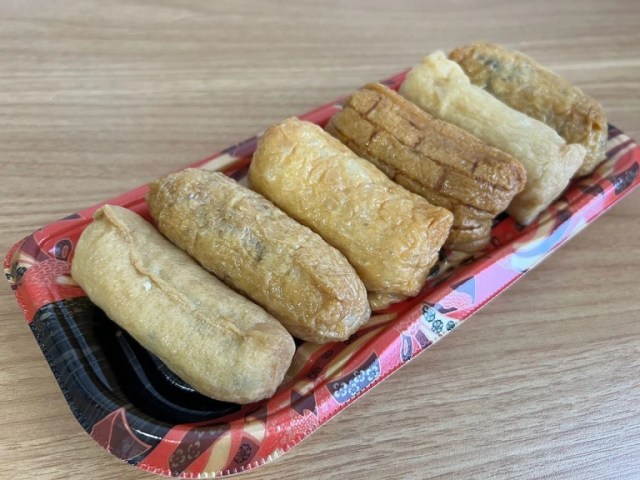
Unassuming inarizushi just might be the best bento to grab at Tokyo Station.
Inside JR Tokyo Station, there are a lot of…well, there’s a lot of everything. A lot of train lines (10 regular and four Shinkansen). A lot of people (almost half a million passengers a day). And a lot of bento boxed lunch options.
With too many bento options to count but only one stomach, obviously you’re going to have to narrow down your choices. Helpfully, Gransta and Ecute Tokyo (a pair of shopping areas connected to and within JR Tokyo Station) have recently released a list of their most popular, best-selling bento.
At the top of the ranking is the premium Jo-nigiri sushi set from Tsukiji Takewaka’s Gransta branch, and at number three is the Fukagawa Bento with Fukagawa-meshi, a dish where rice and clams are steamed in the same pot, from Tsukiji Kiyomura. Since the Gransta/Ecute bento rankings exclude bento from other regions shipped in to Tokyo Station, it’s not surprising to see sushi and Fukagawa-meshi in the top three, as they’re both things Tokyo is famous for. What did surprise us, though, is the second-most popular JR Tokyo Station bento: the Gransta-Exclusive Six-piece Inarizushi Assortment from Mameda.
Inarizushi is a kind of sushi in which vinegared rice is wrapped in a thin sheet of fried tofu. Different shops and restaurants will mix different things in with the rice for different flavors, but with Mameda’s inarizushi set sandwiched between the more luxurious sushi and Fukagawa-meshi bento, we wondered what made it so popular, so we decided to try it for ourselves.
Sure enough, when we arrived at Mameda’s counter inside the JR Tokyo Station ticket gates on basement level 1, there was a line of people waiting to buy their inarizushi.
▼ Inarizushi
You can order individual pieces, but we went with the Gransta-Exclusive Six-piece Inarizushi Assortment, which is priced at 960 yen (US$6.95).
That price works out to 160 yen per piece, which is a little on the pricy side for inarizushi, but not prohibitively so.
Appearance-wise, these aren’t especially different from the inarizushi you’ll find at Japanese supermarkets. The set gets you one inarizushi each with anago (saltwater eel), shiitake mushroom, wasabi, ginger, and gomoku (carrot, shiitake, and lotus root) fillings. The sixth piece gets a special filling that changes each month, and when we stopped by in July it was myoga (Japanese ginger flower buds).
We tasted them one at a time, and they were all good. However, as a simple dish that Japan’s been eating for generations, inarizushi is almost always good. Even supermarket and convenience store inarizushi is pretty tasty, and while Mameda’s is clearly a step above those, it’s not like it’s going to completely change anyone’s perceptions by reaching some sort of previously unfulfilled potential that we never knew inarizushi had.
But as we continued eating, the Gransta-Exclusive Six-piece Inarizushi Assortment’s number-two ranking started to make sense.
Like we mentioned above, Tokyo Station is the nexus of a lot of different train lines, and while it’s a commuter hub, it’s also one of the primary jumping-off points for travel to other parts of Japan. If you’re going to be spending the next few hours on a train to get to your vacation destination, you’re going to need something to eat along the way, so what’s the best thing to choose?
You want something filling, but not so heavy that you’ll still be stuffed when you get off the train. The opportunity to eat lots and lots of local regional foods is, after all, one of the primary reasons people travel in Japan. And if you’re going to be eating on the train, out of consideration to the other passengers you want something that doesn’t have a strong smell and isn’t going to make a mess.
Inarizushi checks off a lot of those boxes. It has that magical filling-but-light quality that’ll keep your stomach from rumbling but still leave you with space to go get some Nagoya chicken wings, Kyoto green tea sweets, or Hiroshima okonomiyaki as soon as you get off the train. There’s no risk of splashing and little chance of spilling anything as you eat it. Mameda’s six-flavor assortment gives you some variety to enjoy without having to run around to a bunch of different shops or hash out the selections yourself if you’re in a hurry to get to your platform, and it’s also easy to share with friends, family, or whoever else you’re traveling with.
Taking all that into consideration, Mameda’s inarizushi set really is a great choice, not necessarily as a culinary destination itself, but as arguably the ideal part-of-the-journey meal.
Shop information
Mameda (Gransta branch) / 豆狸(グランスタ店)
Address: Tokyo-to, Chiyoda-ku, Marunouchi 1-9-1, inside JR Tokyo Station ticket gates, basement level 1, near Marunouchi Chika Chuo Gate
東京都千代田区丸ノ内1-9-1 JR東京駅改札内B1F 丸の内地下中央口改札
Open 8 a.m.-10 p.m. (Monday-Saturday), 8 a.m.-9 p.m. (Sunday, holidays)
Website
Photos ©SoraNews24
● Want to hear about SoraNews24’s latest articles as soon as they’re published? Follow us on Facebook and Twitter!

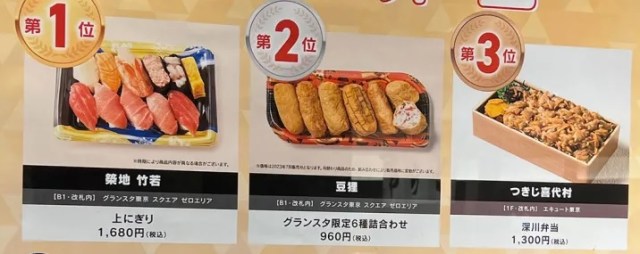
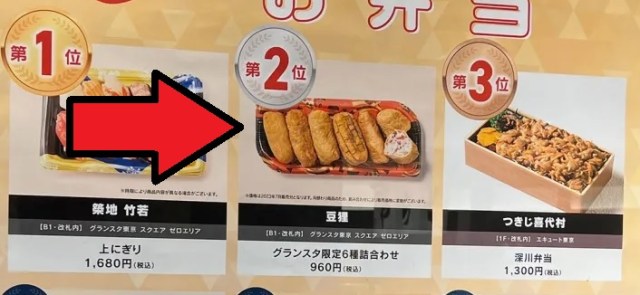
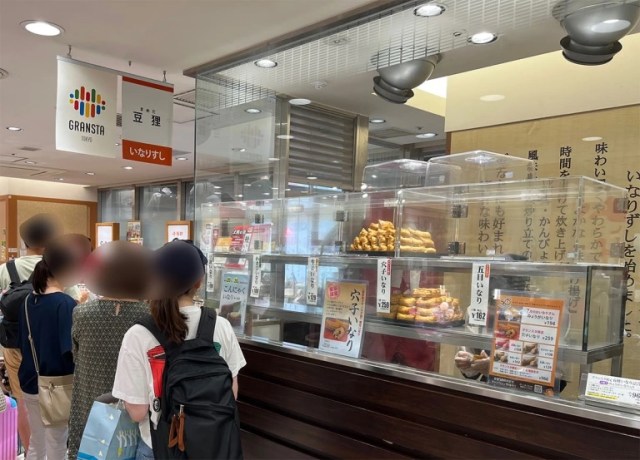
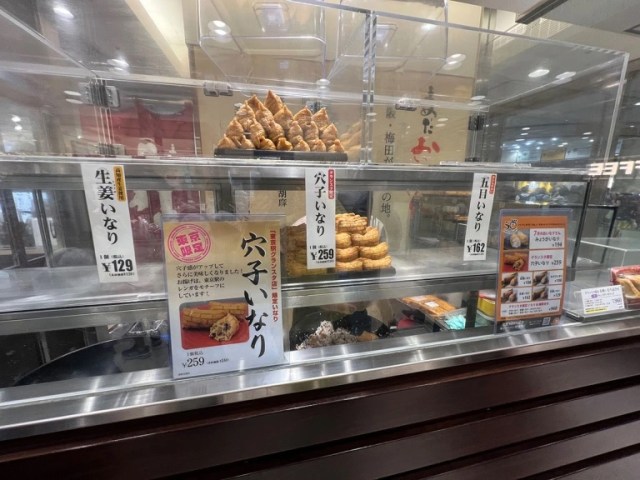
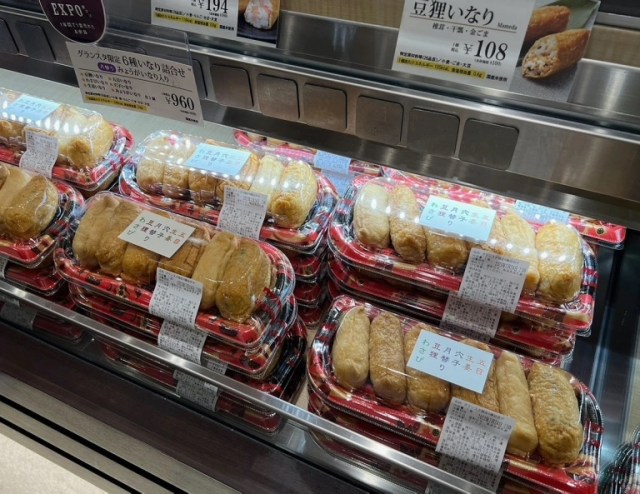
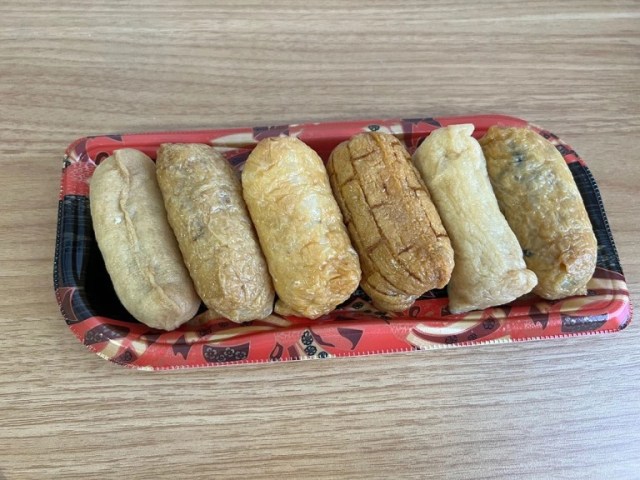
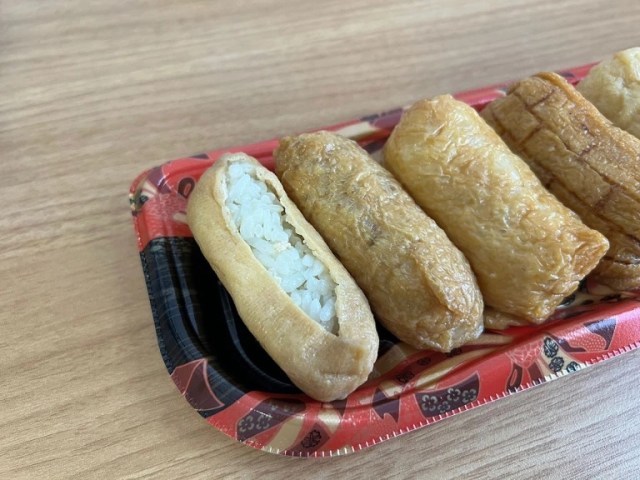

 Restaurant by Tokyo SkyTree perfects Inari Sushi, sells nothing else for 40 years
Restaurant by Tokyo SkyTree perfects Inari Sushi, sells nothing else for 40 years Japanese boxed lunches pulling into France at authentic bento stand opening in Paris station
Japanese boxed lunches pulling into France at authentic bento stand opening in Paris station Hungry and on the go? Top 10 ranking of ekiben at Tokyo’s Shinagawa Station
Hungry and on the go? Top 10 ranking of ekiben at Tokyo’s Shinagawa Station This homemade panda sushi from Japan contains no meat or fish, but tons of cuteness
This homemade panda sushi from Japan contains no meat or fish, but tons of cuteness Takoyaki…inarizushi? New fusion food boggles the mind in Japan
Takoyaki…inarizushi? New fusion food boggles the mind in Japan Foreigner’s request for help in Tokyo makes us sad for the state of society
Foreigner’s request for help in Tokyo makes us sad for the state of society Seaside scenery, history, and so many desserts on Yokohama’s Akai Kutsu【Japan Loop Buses】
Seaside scenery, history, and so many desserts on Yokohama’s Akai Kutsu【Japan Loop Buses】 Should you add tartar sauce to Japanese curry rice? CoCo Ichi makes diners an unusual offer
Should you add tartar sauce to Japanese curry rice? CoCo Ichi makes diners an unusual offer Japanese city loses residents’ personal data, which was on paper being transported on a windy day
Japanese city loses residents’ personal data, which was on paper being transported on a windy day McDonald’s new Happy Meals offer up cute and practical Sanrio lifestyle goods
McDonald’s new Happy Meals offer up cute and practical Sanrio lifestyle goods French Fries Bread in Tokyo’s Shibuya becomes a hit on social media
French Fries Bread in Tokyo’s Shibuya becomes a hit on social media Mt. Koya planning to instate visitor’s tax to cope with huge tourist numbers
Mt. Koya planning to instate visitor’s tax to cope with huge tourist numbers Red light district sushi restaurant in Tokyo shows us just how wrong we were about it
Red light district sushi restaurant in Tokyo shows us just how wrong we were about it Harajuku Station’s beautiful old wooden building is set to return, with a new complex around it
Harajuku Station’s beautiful old wooden building is set to return, with a new complex around it Kyoto’s 100 Demons yokai monster parade returns!
Kyoto’s 100 Demons yokai monster parade returns! Japanese ramen restaurants under pressure from new yen banknotes
Japanese ramen restaurants under pressure from new yen banknotes Studio Ghibli releases new action figures featuring Nausicaä of the Valley of the Wind characters
Studio Ghibli releases new action figures featuring Nausicaä of the Valley of the Wind characters New private rooms on Tokaido Shinkansen change the way we travel from Tokyo to Kyoto
New private rooms on Tokaido Shinkansen change the way we travel from Tokyo to Kyoto Tokyo Tsukiji fish market site to be redeveloped with 50,000-seat stadium, hotel, shopping center
Tokyo Tsukiji fish market site to be redeveloped with 50,000-seat stadium, hotel, shopping center Beautiful Ghibli sealing wax kits let you create accessories and elegant letter decorations【Pics】
Beautiful Ghibli sealing wax kits let you create accessories and elegant letter decorations【Pics】 Studio Ghibli releases Kiki’s Delivery Service chocolate cake pouches in Japan
Studio Ghibli releases Kiki’s Delivery Service chocolate cake pouches in Japan New definition of “Japanese whiskey” goes into effect to prevent fakes from fooling overseas buyers
New definition of “Japanese whiskey” goes into effect to prevent fakes from fooling overseas buyers Our Japanese reporter visits Costco in the U.S., finds super American and very Japanese things
Our Japanese reporter visits Costco in the U.S., finds super American and very Japanese things All-you-can-drink Starbucks and amazing views part of Tokyo’s new 170 meter-high sky lounge
All-you-can-drink Starbucks and amazing views part of Tokyo’s new 170 meter-high sky lounge More foreign tourists than ever before in history visited Japan last month
More foreign tourists than ever before in history visited Japan last month New Pokémon cakes let you eat your way through Pikachu and all the Eevee evolutions
New Pokémon cakes let you eat your way through Pikachu and all the Eevee evolutions Disney princesses get official manga makeovers for Manga Princess Cafe opening in Tokyo
Disney princesses get official manga makeovers for Manga Princess Cafe opening in Tokyo Sales of Japan’s most convenient train ticket/shopping payment cards suspended indefinitely
Sales of Japan’s most convenient train ticket/shopping payment cards suspended indefinitely Sold-out Studio Ghibli desktop humidifiers are back so Totoro can help you through the dry season
Sold-out Studio Ghibli desktop humidifiers are back so Totoro can help you through the dry season Japanese government to make first change to romanization spelling rules since the 1950s
Japanese government to make first change to romanization spelling rules since the 1950s Ghibli founders Toshio Suzuki and Hayao Miyazaki contribute to Japanese whisky Totoro label design
Ghibli founders Toshio Suzuki and Hayao Miyazaki contribute to Japanese whisky Totoro label design Doraemon found buried at sea as scene from 1993 anime becomes real life【Photos】
Doraemon found buried at sea as scene from 1993 anime becomes real life【Photos】 Tokyo’s most famous Starbucks is closed
Tokyo’s most famous Starbucks is closed One Piece characters’ nationalities revealed, but fans have mixed opinions
One Piece characters’ nationalities revealed, but fans have mixed opinions We asked a Uniqlo employee what four things we should buy and their suggestions didn’t disappoint
We asked a Uniqlo employee what four things we should buy and their suggestions didn’t disappoint Princesses, fruits, and blacksmiths: Study reveals the 30 most unusual family names in Japan
Princesses, fruits, and blacksmiths: Study reveals the 30 most unusual family names in Japan Japan’s favorite pork cutlet sandwich maker also has awesome katsudon restaurant in Tokyo Station
Japan’s favorite pork cutlet sandwich maker also has awesome katsudon restaurant in Tokyo Station The ultimate Shinkansen trip: Riding Japan’s bullet train network from one end to the other
The ultimate Shinkansen trip: Riding Japan’s bullet train network from one end to the other Is this your lucky day? Announcing the winner of our Kyoto book and DVD giveaway!
Is this your lucky day? Announcing the winner of our Kyoto book and DVD giveaway! We tried a gourmet chocolate bento box worth 2,700 yen, and every bite was worth it
We tried a gourmet chocolate bento box worth 2,700 yen, and every bite was worth it Should strong-smelling foods be banned from bullet trains? Japanese citizens debate
Should strong-smelling foods be banned from bullet trains? Japanese citizens debate Tokaido Shinkansen ending in-train food/drink sales for all non-first-class-passenger cars
Tokaido Shinkansen ending in-train food/drink sales for all non-first-class-passenger cars Three Kyoto sushi shops are sending girls reeling in culinary delight
Three Kyoto sushi shops are sending girls reeling in culinary delight Taste the floor of a Japanese train station with new limited-edition chocolates from Tokyo Metro
Taste the floor of a Japanese train station with new limited-edition chocolates from Tokyo Metro Tokyo Banana’s Legendary Curry Bread tests the limits of what makes a good karepan 【Taste test】
Tokyo Banana’s Legendary Curry Bread tests the limits of what makes a good karepan 【Taste test】 Tokyo Station Waterscape Toilet looks more like an aquarium than a bathroom
Tokyo Station Waterscape Toilet looks more like an aquarium than a bathroom Official Sailor Jupiter bento boxed lunches being served now at Tokyo anime-themed cafe 【Photos】
Official Sailor Jupiter bento boxed lunches being served now at Tokyo anime-themed cafe 【Photos】 Cute ekiben station bento looks like it’s from Japan but it’s from a different place entirely
Cute ekiben station bento looks like it’s from Japan but it’s from a different place entirely The 5 best Japanese bento to buy at Kyoto Station
The 5 best Japanese bento to buy at Kyoto Station We try Keiji, an incredibly rare and expensive one-in-ten-thousand salmon sushi 【Taste test】
We try Keiji, an incredibly rare and expensive one-in-ten-thousand salmon sushi 【Taste test】 Tokyo airport’s new train line to make getting into, out of the city easier for JR pass holders
Tokyo airport’s new train line to make getting into, out of the city easier for JR pass holders
Leave a Reply